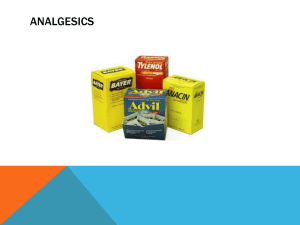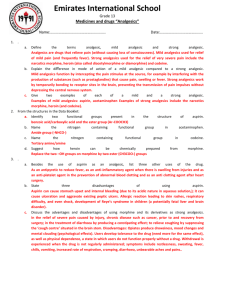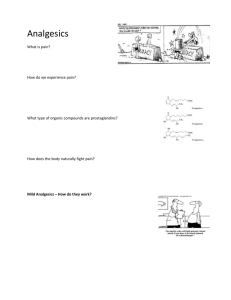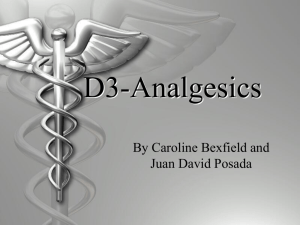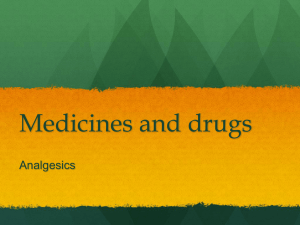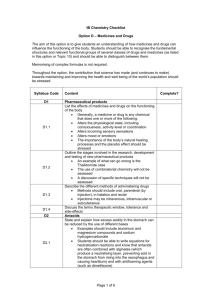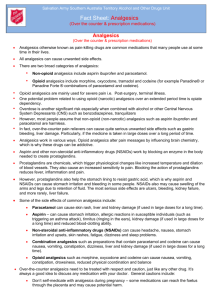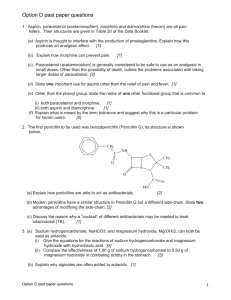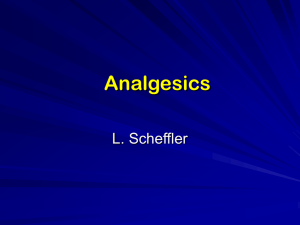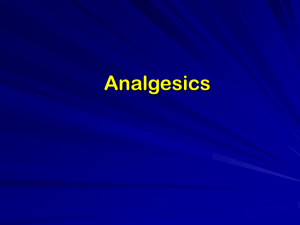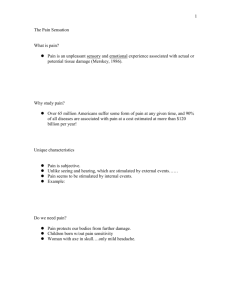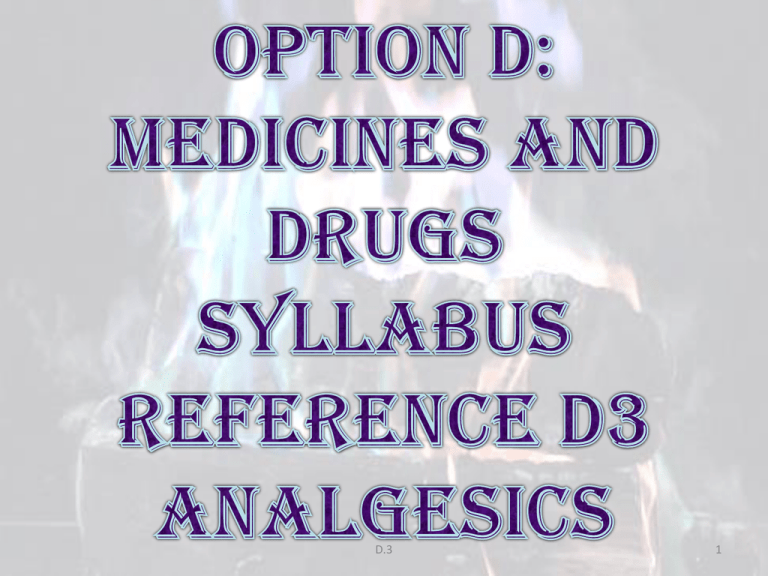
D.3
1
D.3.1 Describe and
explain the different
ways that analgesics
prevent pain.
Objectives:
3
D.3
2
ANALGESICS is derived from the word
ANALGESIA, which means a sense of
well being. Analgesics are basically pain
and fever relievers.
D.3
3
D.3.1
Analgesics can be of two types,
•The Strong Analgesics (Commonly
known as narcotics)
•The Mild Analgesics (Non-narcotics)
Both analgesics work in similar waysThey prevent the brain from detecting
pain and other such unpleasant stimuli.
However, the manner in which this is
done varies.
D.3
4
1. Mild analgesics intercept the pain stimulus at the source. This interception is
created by the interference with the production of prostaglandins (Chemicals that
cause pain, fever and swelling), i.e.: They
•REDUCE PAIN
2. Furthermore, they cause the blood vessels near the pain source to constrict,
thereby
• REDUCING INFLAMMATION
3. Due to the reduction in the production of prostaglandins, the temperature of the
person decreases, thus
•REDUCING FEVER
ALSO: Aspirin, a mild analgesic, also has anti blood coagulation properties, and this
is used in the treatment of heart attacks and strokes.
EXAMPLES OF MILD ANALGESICS:
1. Aspirin
2. Ibuprofen
3. Paracetamol
D.3
5
IBUPROFEN
ASPIRIN
D.3
ACETAMINOPHEN
6
Strong analgesics are more “radical” than the mild analgesics,
and it is this property that makes them so restricted in usage.
Strong analgesics prevent the transmission of the pain by
binding with the pain receptors in the brain and blocking the
communication of pain signals between brain cells.
They also mimic the body’s own natural painkillers (namely
endorphins and encephalin), ergo producing a sense of well
being.
EXAMPLES OF STRONG ANALGESICS INCLUDE:
1. Heroin
2. Codeine
3. Morphine
D.3
7
D.3
8
D.3.2 Describe the use of
derivatives of salicylic acid as
mild analgesics, and compare the
advantages and disadvantages of
using aspirin and paracetamol
(acetaminophen)
Objectives: 3
D.3
9
Salicylic acid reacts in the following manner to form
aspirin:
Salicylic Acid + Acetic Anhydride Acetylsalicylic acid
+ Acetic Acid
C7H6O3 + C4H6O3 C9H8O4 + C2H4O2
D.3
10
ASPIRIN is considered a NSAID (Nonsteroidal Anti-inflammatory drug), which can
help treat “headaches, toothaches and sore
throats… [as well as minimize] fever…and
inflammation.” (Brown and Ford 341)
Being a mild analgesic, aspirin prevents the
formation of prostaglandin at its source and
stops the transmission of the pain stimulus to
the brain.
D.3
11
ASPIRIN
contains:
•A benzene
ring
•A
carboxylic
acid group
•An ester
group
D.3
12
• It minimizes the coagulation of blood, and is
thus given to individuals with the risk of a heart
attack or stroke.
• It helps to relieve the symptoms of arthritis and
rheumatism.
• It is non-addictive.
D.3
13
• It causes bleeding in the lining of the stomach.
• It may also cause the formation of ulcers on the lining
of the stomach.
• It is associated with bronchial asthma.
• Children under the age of twelve, who have been
consuming Aspirin on a regular basis, have been
associated with Reye’s disease. Reye’s disease is a fatal
disease of the liver and the brain with symptoms of
vomiting, lethargy, irritability, and confusion.
•Overdose of aspirin causes acidosis caused due to a
lowering of the pH of the blood.
D.3
14
Acetaminophen is a pain killer, which is
similar to aspirin, however does not act as
an anti-inflammatory. It acts by
minimizing the production of
prostaglandin in the brain, while the
production of prostaglandins in the rest of
the body remain unaffected. It is rather
safe for consumption by adults and
children alike.
D.3
15
PARACETAMOL
contains:
•A benzene ring
•A hydroxy group
•An amide group
D.3
16
Advantages include:
•It reduces fevers caused by the cold or the
flu.
•It helps relieve pains caused in the
muscles, like menstrual cramps, and also
joint aches.
•It is not addictive.
•It is a very safe analgesic.
D.3
17
•They are ineffective in
reducing inflammation.
•Paracetamol is a safe
analgesic, however, if
overused, can cause kidney
and liver damage, and also
brain damage, or in some
cases, death.
D.3
18
Ibuprofen is in a group of drugs called
non-steroidal anti-inflammatory drugs
(NSAIDs). It works by reducing
hormones that cause inflammation and
pain in the body.
Ibuprofen is used to reduce fever and
treat pain or inflammation caused by
many conditions such as headache,
toothache, back pain, arthritis,
menstrual cramps, or minor injury.
D.3
19
IBUPROFEN
contains:
•A benzene ring
•A carboxylic
acid group
D.3
20
IBUPROFEN has optical isomers. (Only
the HL people know what this is, so SL
people DO NOT PANIC.)
This is due to the presence of a Chiral
carbon. (Do we remember what that is?)
D.3
21
D.3.3 Compare the
structures of morphine,
codeine and diamorphine
(heroin, a semi-synthetic
opiate).
Objectives: 3
D.3
22
Morphine, Codeine and Diamorphine (heroin) are strong
analgesics which are commonly classified as narcotics.
They are extracted from the unripe seeds of the poppy
plant and are called OPIATES.
They are available only under prescription, and are given
to individuals with SEVERE
Cases of pain, e.g.: Heart attacks,
Injuries and sometimes cancer.
D.3
23
D.3
24
D.3
Morphine has the
molecular formula
C17H19NO3, and is
chemically called
“(5α,6α)-Didehydro4,5-epoxy-17methylmorphinan3,6-diol”.
The structure contains
an alcohol, a phenol,
an amine and an ester
group.
25
MORPHINE VIDEO:
http://www.youtube.c
om/watch?v=o9Lmjk
Mp9Nc&feature=fvsr
D.3
26
D.3
27
Codeine has the molecular
formula C18H21NO3, and is
chemically called “(5(,6()7,8-didehydro-4,5-epoxy3-methoxy-17methylmorphinan-6-ol”.
The structure contains a
hydroxy group, a tertiary
amine, an alkene group, a
benzene ring and an ether
group.
D.3
28
D.3
29
D.3
Diamorphine, commonly
known as heroin, is a semisynthetic opiate, which
interacts with pain receptor
sites within the brain and
blocks pain stimuli. It has a
molecular formula
C21H23NO5 , and is
chemically named (5α,6α)7,8-didehydro-4,5-epoxy17-methylmorphinan-3,6diol acetate.
Its structure contains two
ester groups, a tertiary
amine group, a benzene
ring, an alkene group and an
ether group.
30
Morphine is converted to heroin
by reacting it with acetic
anhydride or acetyl chloride. It is
an esterification reaction, or it
can also be labeled a
condensation reaction.
D.3
31
DIFFERENTIATING BETWEEN THE 3.
Check this out:
http://education.sdsc.edu/download/chemistry/anal
gesics.swf
It shows us the differences in both, the molecular
and the linear structures.
D.3
32
D.3
33
D.3.4 Discuss the
advantages and
disadvantages of using
morphine and its derivatives
as strong analgesics.
Objectives: 3
D.3
34
Morphine and its derivative narcotics are the
strongest painkillers and are available only
under prescription. They are used to treat the
pain caused by severe injury, and also by
heart attacks. Some are even used to reduce
labour pains during childbirth, as they are
injected as an epidural. They act on specific
areas of the brain and spinal cord that
process pain signals from nerves throughout
the body.
D.3
35
SHORT TERM EFFECTS
LONG TERM EFFECTS
Dulling of pain
Addiction and very strong withdrawal
effects
Euphoria
Loss of libido
Slow Nervous System
Constipation
Slow Heart Rate
Disruption in menstruation
Loss of cough reflex
Loss of appetite
Nausea
Problems associated with the purchase of
“street-drugs”, e.g.: Increased risk of AIDS
from the sharing of needles.
Overall slow down of biological systems.
Overdose can lead to death, or a possibility
of stroke.
D.3
36
SERIOUS EFFECTS
COMMON EFFECTS
LESS COMMON EFFECTS
Confusion
Dizziness or lightheadedness
Mood swings
Severe drowsiness, dizziness, Nausea or vomiting
or weakness
False sense of analgesia
(Euphoria)
Slurred Speech
Constipation
Urinary retention
Small, constricted pupils
Drowsiness
Jerky body movements
(myoclonus)
Cold and clammy skin
Itching
Hallucinations
Slow breathing
Sweating
Seizures
Loss of consciousness
D.3
37
WORKS CITED
•http://www.herbs2000.com/medica/morphin
e.htm
•http://www.chemistry-drills.com/functionalgroups.php?q=simple
•http://education.sdsc.edu/download/chemistr
y/analgesics.swf
•Unlisted Documents
•IB Chemistry Course Companion
•Google Image Search
Sorry I didn’t feel like sticking to the MLA format.
D.3
38
WARNING: Individuals
with weak hearts, other
health care issues, and
severe paranoia or the
hatred for the medical
field et al… SHUT YOUR
EYES! The content
following this slide is
GRAPHIC.
D.3
39
The basic thing nobody asks is why do
people take drugs of any sort? Why do
we have these accessories to normal
living to live? I mean, is there
something wrong with society that's
making us so pressurized, that we
cannot live without guarding ourselves
against it?
-John Lennon
D.3
40
D.3
41
D.3
42
D.3
43
D.3
44
D.3
45
D.3
46
D.3
47
D.3
48
D.3
49

